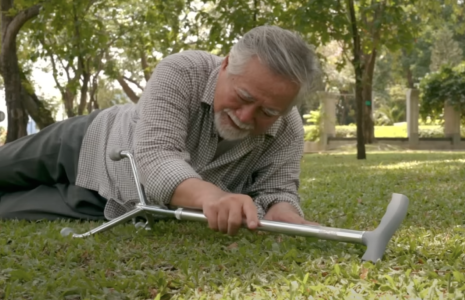41,000 older Americans died from falls in 2023—Here’s how to stay safe
- Replies 0
Every year, millions of Americans over 65 look forward to enjoying retirement—traveling, spending time with family, and savoring the freedom that comes with a well-earned break.
But there’s a silent threat lurking in our homes and communities, one that claimed the lives of more than 41,000 retirement-age Americans in 2023 alone: falls.
Yes, you read that right. According to the latest data from the Centers for Disease Control and Prevention (CDC), unintentional falls are on the rise among older adults, and the numbers are sobering.
The risk increases dramatically with age, doubling for those 85 and older compared to their younger peers. But here’s the good news: most falls are preventable, and a few simple changes can make a world of difference.
Why Are Falls Increasing Among Older Adults?
The CDC’s National Center for Health Statistics found that from 2003 to 2023, the death rate from falls increased by more than 70% for adults ages 65 to 74, and by over 75% for those aged 75 to 84.
For those 85 and older, the rate more than doubled. While the report didn’t dig into the reasons behind this alarming trend, experts have a few ideas:

Your Fall-Prevention Toolkit: Simple Steps for a Safer Life
1. Stay Physically Active
It’s no secret—our muscles and balance aren’t quite what they used to be. But the best way to fight back is to keep moving! Regular physical activity helps maintain strength, flexibility, and coordination. Consider:
2. Fall-Proof Your Home
Most falls happen at home, but a few tweaks can make your space much safer:
Also read: Simple chair exercises every older adult can do to improve balance and strength at home
3. Use Assistive Devices Proudly!
There’s no shame in using a cane, walker, or other assistive device. In fact, using the right tool can help you stay independent longer.
Make sure your device is properly fitted and that you know how to use it. Don’t forget about other helpful gadgets like raised toilet seats, handrails, and shower chairs.
4. Choose the Right Shoes
Your favorite slippers might be cozy, but they could also be a fall waiting to happen. Opt for sturdy, well-fitting shoes, flat soles with good grip, avoiding high heels, flip-flops, and slick-soled shoes.
Also read: Elder care in danger: Nursing homes shutter as demand soars
5. Keep Up With Your Health
Did you know that fear of falling can actually make you more likely to fall? It’s true! If you’re feeling anxious about your balance, talk to your doctor or a physical therapist. They can recommend exercises and strategies to boost your confidence.
Source: Balance Rehab by Doug Weiss, DPT / Youtube.
7. Stay Social and Engaged
Isolation can lead to inactivity and depression, both of which increase fall risk. Join a walking group, take a class, or simply call a friend for a chat. Staying connected is good for your body and your spirit.
What to Do If You Fall
Even with the best prevention, accidents can happen. If you do fall:
Read next: Over 50? The secret to stronger knees starts here!

Have you or a loved one experienced a fall? What changes have you made to stay safe at home or on the go? Do you have a favorite balance exercise or a tip for making your home safer? Share your stories and advice in the comments below!
But there’s a silent threat lurking in our homes and communities, one that claimed the lives of more than 41,000 retirement-age Americans in 2023 alone: falls.
Yes, you read that right. According to the latest data from the Centers for Disease Control and Prevention (CDC), unintentional falls are on the rise among older adults, and the numbers are sobering.
The risk increases dramatically with age, doubling for those 85 and older compared to their younger peers. But here’s the good news: most falls are preventable, and a few simple changes can make a world of difference.
Why Are Falls Increasing Among Older Adults?
The CDC’s National Center for Health Statistics found that from 2003 to 2023, the death rate from falls increased by more than 70% for adults ages 65 to 74, and by over 75% for those aged 75 to 84.
For those 85 and older, the rate more than doubled. While the report didn’t dig into the reasons behind this alarming trend, experts have a few ideas:
- Longer lifespans: We’re living longer, but with age comes increased frailty and chronic health conditions.
- Medication use: Many older adults take multiple medications, some of which can cause dizziness or drowsiness.
- Vision and hearing changes: Diminished senses can make it harder to spot hazards.
- Home hazards: Clutter, poor lighting, and slippery surfaces are common culprits.

The rate of fatal falls among Americans aged 65 and over has risen sharply over the past two decades, with more than 41,000 deaths recorded in 2023 and those aged 85 and older most at risk. Image source: Balance Rehab by Doug Weiss, DPT / Youtube.
Your Fall-Prevention Toolkit: Simple Steps for a Safer Life
1. Stay Physically Active
It’s no secret—our muscles and balance aren’t quite what they used to be. But the best way to fight back is to keep moving! Regular physical activity helps maintain strength, flexibility, and coordination. Consider:
- Walking: A daily stroll is great for your legs and your mood.
- Tai Chi or Yoga: These gentle exercises are fantastic for balance and flexibility.
- Strength Training: Light weights or resistance bands can help keep muscles strong.
2. Fall-Proof Your Home
Most falls happen at home, but a few tweaks can make your space much safer:
- Clear the Clutter: Keep walkways free of cords, shoes, and other tripping hazards.
- Secure Rugs: Use double-sided tape or non-slip pads to keep rugs in place.
- Light It Up: Make sure hallways, stairs, and bathrooms are well-lit. Nightlights are a great addition!
- Install Grab Bars: Place them in the bathroom near the toilet and in the shower or tub.
- Non-Slip Mats: Use these in the shower, tub, and on any slippery floors.
Also read: Simple chair exercises every older adult can do to improve balance and strength at home
3. Use Assistive Devices Proudly!
There’s no shame in using a cane, walker, or other assistive device. In fact, using the right tool can help you stay independent longer.
Make sure your device is properly fitted and that you know how to use it. Don’t forget about other helpful gadgets like raised toilet seats, handrails, and shower chairs.
4. Choose the Right Shoes
Your favorite slippers might be cozy, but they could also be a fall waiting to happen. Opt for sturdy, well-fitting shoes, flat soles with good grip, avoiding high heels, flip-flops, and slick-soled shoes.
Also read: Elder care in danger: Nursing homes shutter as demand soars
5. Keep Up With Your Health
- Vision and Hearing: Get your eyes and ears checked regularly. Wear glasses or hearing aids as prescribed.
- Medication Review: Some medications can make you dizzy or sleepy. Ask your doctor or pharmacist to review your prescriptions and over-the-counter meds for side effects or interactions.
- Manage Chronic Conditions: Conditions like diabetes, arthritis, or low blood pressure can increase fall risk. Stay on top of your health!
Did you know that fear of falling can actually make you more likely to fall? It’s true! If you’re feeling anxious about your balance, talk to your doctor or a physical therapist. They can recommend exercises and strategies to boost your confidence.
Source: Balance Rehab by Doug Weiss, DPT / Youtube.
7. Stay Social and Engaged
Isolation can lead to inactivity and depression, both of which increase fall risk. Join a walking group, take a class, or simply call a friend for a chat. Staying connected is good for your body and your spirit.
What to Do If You Fall
Even with the best prevention, accidents can happen. If you do fall:
- Stay calm. Take a few deep breaths.
- Check for injuries If you’re hurt, try to call for help or use a medical alert device.
- If you’re not hurt, roll onto your side, get onto your hands and knees, and use a sturdy piece of furniture to help you stand.
Read next: Over 50? The secret to stronger knees starts here!
Key Takeaways
- The rate of fatal falls among Americans aged 65 and over has risen sharply over the past two decades, with more than 41,000 deaths recorded in 2023 and those aged 85 and older most at risk.
- Staying physically active by working on strength, balance, flexibility and coordination can greatly help reduce the likelihood of falls as we age.
- Fall-proofing your home, such as removing trip hazards, adding nonslip mats, and improving lighting, can make the environment much safer for older adults.
- Using appropriate assistive devices, wearing sturdy shoes with nonslip soles, regularly monitoring your health, and managing medications and sensory issues are all important steps in preventing falls.
Have you or a loved one experienced a fall? What changes have you made to stay safe at home or on the go? Do you have a favorite balance exercise or a tip for making your home safer? Share your stories and advice in the comments below!






